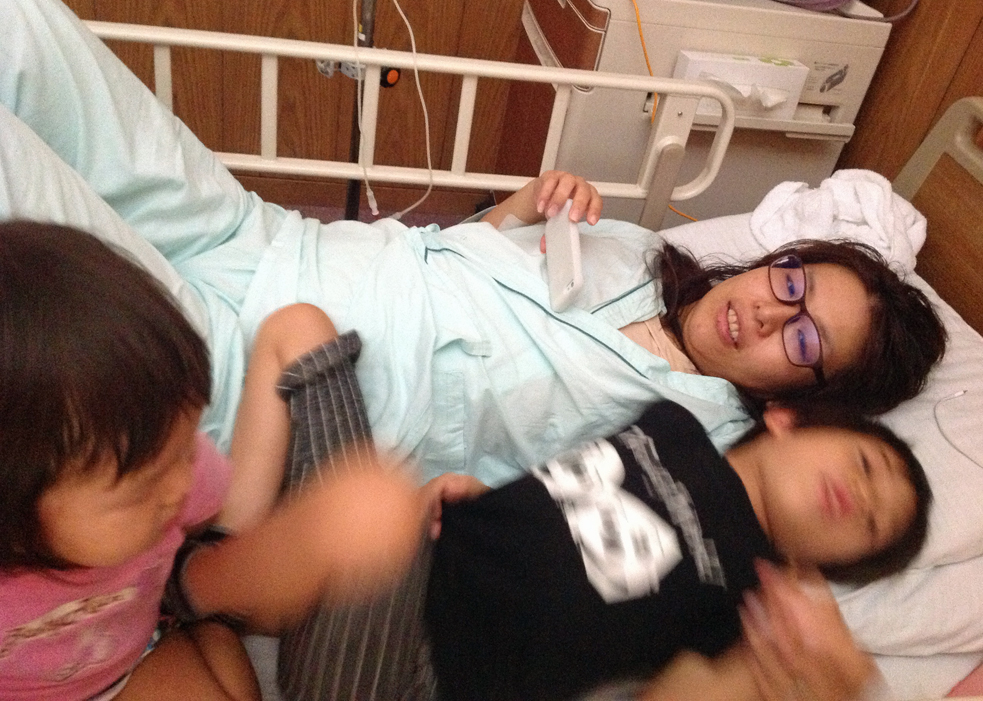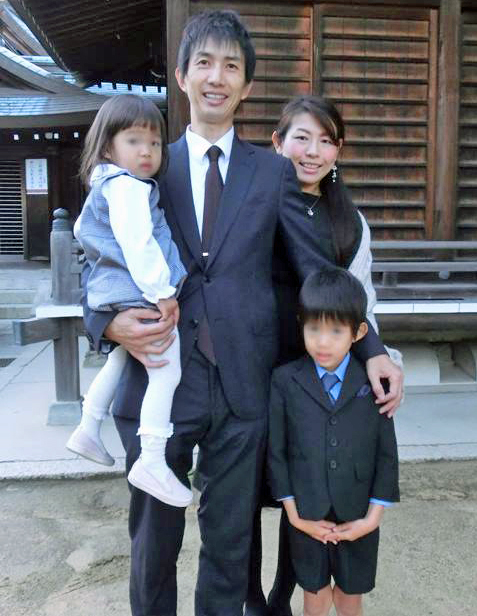
Ai Tokimatsu watches a TED Talk on her phone in the hospital, with her two children. Photo: Courtesy Ai Tokimatsu
The illness hit me on a beautiful summer weekend. I woke up early and did an hour of exercise, feeling very excited to take my children to a local festival that evening. We all put on our summer kimonos, called yukata—my then 5-year-old son turned into a little samurai and my 2-year-old girl became a princess. It could have been one of those perfect days that you cherish for the rest of your life.
Earlier in the day, my 2-year-old daughter was playing in our living room and jumped on me. I caught her in an awkward position, and felt something wrong in my back—something heavy and a bit painful. At first, I thought I had hurt my back, but after we came back from the festival, something else seemed to be wrong. I broke into a sweat, had shortness of breath, felt fatigued, and my temperature kept going up. I thought I had caught a bad cold in addition to the back pain—I never put the two together as something more serious.
Like millions of other mothers, I tend to put myself last on the to-do list. I thought I just needed a good night’s rest and a Tylenol. My husband, Hideo, had a different idea. He was there for me when I battled CFS/FM (chronic fatigue syndrome/fibromyalgia) for seven years and had seen me very sick. He knew that something was really wrong this time, too. He insisted on taking me to a hospital. A hospital? I thought. No way! I didn’t want to wait on an uncomfortable hospital bench, trying to sooth my children for hours. Hideo had just started a new job, and I knew that he couldn’t afford to take a day off.
Despite my protests, he dragged me and the kids to the hospital the next morning. By the time I was officially hospitalized, I had passed out several times. I remember two hallucinations I had repeatedly. The first one was the image of parents smiling big with their running strollers—it made sense, as I had founded Baby Run, an exercise program for parents, in 2009. The second image was a TEDx speaker sparkling on the stage, leaving everyone in awe. I was viewing it as if from the backstage as a staff member—again accurate since I helped organize a TEDx event. I’m not sure if my hallucinations were a near-death experience or not, but I believe what you recall during the most difficult times tells you what kind of person you are.
At the TEDxKyoto speaker audition in 2013, I had stepped onto the stage myself and talked about my experience overcoming CFS/FM and starting Baby Run after my son was born. The talk was about how I stood up from a bed-bound situation. But doing this once was rough enough. “Oh, come on, not again!” I thought. “I want a happy ending! Why does my story of struggle have to have a sequel? Is this going to be like Die Hard 2? What if there’s a part 3 and 4?” I begged, “Oh, please, I am not that strong!”
The doctors explained: I had sepsis. It was caused by an infection that spread from my bladder to my kidneys, where my veins carried it to the rest of my body. I was unaware of the infection—the only discomfort initially had been the dull pain in my lower back. But it was serious—while I barely knew its name, sepsis has high death rates even in developed countries.
The real journey began, though, after I was released from the hospital. Unexplainable pain persisted for more than five months. Every single time I moved a little, the pain got worse. So, I had no choice—I stayed in the bed all day long. Again. Hideo was so supportive. He got up at 4 o’clock in the morning, cooked for the day, went to work until very late at night, came back home, cleaned up the mess and repeated the pattern again a few hours later.
I, on the other hand, cuddled up in bed all day long. For a busy mother, a few days off sounds like a dream—but being bed-bound long-term is a nightmare. I wished I could do something for my family. We visited several doctors but I always ended up with more fatigue and pain. Even a psychiatrist couldn’t help, explaining that the pain wasn’t rooted in my mind. We were lost. We needed a clear answer. My husband and I often encouraged each other, saying it had been only months—and we had gone through much worse for years. This pain was only in the lower right side of my back—with CFS/FM, I’d felt it throughout my entire body. This was a better situation, we kept saying to ourselves.
I spent most of the day reading and watching movies. I guess I was trying to learn from the great wisdom of the past as I went through these dark hours. Of course, I also watched a lot of TED and TEDx talks. These videos were just perfect while I was in pain.
Most of the videos I watched had Japanese subtitles, since that was easier for me to follow. But sometimes there were great talks and Japanese subtitles simply hadn’t been written yet. There are millions of people waiting for these kinds of stories, I thought. I got curious, wondering: who translates these talks?
After some online research, I discovered TED’s Open Translation Project, a global community working hard to bring talks beyond the English-speaking world. I applied to be a part of it on the spot. The very next day, I became part of an incredible team that I can only describe in two words: very Japanese. The translators I worked with are introverted, but deep thinkers. They didn’t make a fuss about the contributions they were making—and yet their work helped spread ideas to people all around Japan. I wished I had started OTP earlier.
The first talk I reviewed was “A child of the State” by Lemn Sissay. It really resonated with me. My mother left my family when I was 14 and, at the time, a lot of people insisted that my father put me and my brother into a government facility. Luckily, my father kept us. A teenager at the time, I felt insecure and was getting bad grades in school. In fact, I began to study English to set myself free from the stereotypes of what Japanese girls should be. As Lemn Sissay says in his talk, “It’s not that I’d had the rug pulled from beneath me as much as the entire floor had been taken away.” I know how that feels. If I could use my English skills to make this story heard in Japan, I couldn’t be happier. A translator is not allowed to change the story; a translator has to deliver it as-is. I was sure I could take on that task.
It was sometimes difficult to use a computer due to the pain. So I printed out the talk’s transcript and translated it the old-fashioned way, using paper and pencil. When the pain was too much and I couldn’t move, I would shout for my husband, “I just came up with a better translation. Would you write it down for me!?” Hideo was incredibly supportive of my joining OTP. He liked seeing me active and said that it helped motivate him to juggle multiple tasks. “You are the one,” he kept saying, “who spreads the ideas no matter where you are and how you feel.”
It took five months to recover from sepsis. Today, the pain is gone, and I am finally busy again. I spend most of my time with my children and have slowly resumed work with Baby Run. And then there are the endless house chores—which make me happy, at least most of the time. But even now, with much less free time, I am honored to continue to spread the ideas as a member of the OTP community.
Has a TED Talk helped you through a hard time? Write kate@ted.com and tell her your story.

Hideo and Ai Tokimatsu with their children, now. Photo: Ai Tokimatsu
Comments (16)